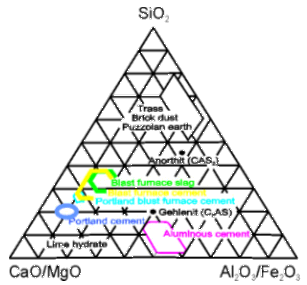Cement is a fast working binder that hardens under water and in the air and serves as raw material for concrete and mortar.
The main raw materials for Portland cement are limestone and / or limestone (CaCO3) and clay (SiO2 and Al2O3). Those are crushed with small amounts of iron containing additives and coal fly ash and heated to sintering at about 1,450°C to cement clinker. This is done in a large rotating furnace. The ground clinker is (hydraulic) cement.
Portland cement is a product of burning limestone and clay in coal ovens, named after the English Isle of Portland.
 Blast Furnace Cement is a type of cement in which slag is mixed. It reacts slower than Portland cement, but at very high temperatures it is faster.
Blast Furnace Cement is a type of cement in which slag is mixed. It reacts slower than Portland cement, but at very high temperatures it is faster.
Blast furnace cement is better than Portland cement resistant to attack by sulphates in e.g. waste water, sea water and manure. Concrete with blast furnace cement also has better resistance to the penetration of chlorides from seawater and sprinkle with salt.
When making mortar or concrete the first 1.5 hours noting happens yet and the mixture may still be poured or handled. Then cement begins to ”react” with water. It creates endless, long thin hairs that form a hard stone. These hairs are sticking sand and gravel grains together. As long as cement and water is present, the reaction continues.
Once curing it should no more be moved. Then the thin ”hairs” break and they do not repair.
The cement can bind about 40% of its own weight to water. So in order to react at all 1 kilo of cement, 400 gr water is required. This ratio is the water-cement ratio.
Cement really wants to react with water. It must be kept absolutely dry.
Pozzolan is a fine volcanic naturally burned material (of Puzzuoli, at the Gulf of Naples, Italy). Synthetic pozzolana consists of crushed baked materials like clay and coal ash.
Trass is broken and crushed tuff of volcanic origin (Eifel). Trass is a naturally formed pozzolan.
Trass is used as an additive for mortar and concrete, in order to improve process ability.
By chemical reactions in the binding and hardening of concrete and mortar heat is released. For large volumes, this gives stresses in the concrete mass which can occur cracks. Addition of trass slows these reactions. When hardening the mortar or concrete get thus a higher density, and elasticity. By adding trass to concrete it can be made waterproof (basement walls), and there is less cement required.
Pliny the Elder (23 -79) wrote in his Naturalis Historia: "One triturated lime with lard and figs ... this is the most stable spread, it is harder than stone." An unfortunately too brief recipe.
